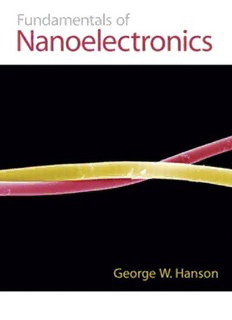
Fundamentals of Nanoelectronics PDF
Preview Fundamentals of Nanoelectronics
Fundamentals of Nanoelectronics George W. Hanson Dept. of Electrical Engineering & Computer Science University of Wisconsin at Milwaukee Upper Saddle River, New Jersey 07458 LibraryofCongressCataloging-in-PublicationData Hanson,GeorgeW. FundamentalsofNanoelectronics/GeorgeW.Hanson.—1sted. p.cm. Includesbibliographicalreferencesandindex. ISBN978-0-13-195708-4 1.Molecularelectronics.2.Nanoelectronics.I.Title. TK7874.8.H372007 621.382—dc22 2007010007 VicePresidentandEditorialDirector,ECS:MarciaJ.Horton AcquisitionsEditor:MichaelMcDonald AssociateEditor:AliceDworkin ExecutiveManagingEditor:VinceO’Brien ManagingEditor:ScottDisanno ProductionEditor:CraigLittle DirectorofCreativeServices:PaulBelfanti CreativeDirector:JuanLopez ArtDirector:JayneConte CoverDesigner:BruceKenselaar ManagingEditor,AVManagementandProduction:PatriciaBurns ArtEditor:GregoryDulles PhotoResearch:SheilaNorman ManufacturingManager:AlexisHeydt-Long ManufacturingBuyer:LisaMcDowell MarketingManager:TimGalligan CoverPhoto:Coloredscanningelectronmicrographoftwointertwinedcarbonnanotubes.Theimageshows approximately15micronsoftube-length.Dr.KostasKostarelosandDavidMcCarthy/SciencePhotoLibrary/ PhotoResearchers,Inc. 2008PearsonEducation,Inc. PearsonPrenticeHall PearsonEducation,Inc. UpperSaddleRiver,NJ07458 Allrightsreserved.Nopartofthisbookmaybereproducedinanyformorbyanymeans,without permissioninwritingfromthepublisher. PearsonPrenticeHall isatrademarkofPearsonEducation,Inc. Allothertrademarksorservicemarksarethepropertyoftheirrespectiveowners. Theauthorandpublisherofthisbookhaveusedtheirbesteffortsinpreparingthisbook.Theseefforts includethedevelopment,research,andtestingofthetheoriesandprogramstodeterminetheir effectiveness.Theauthorandpublishermakenowarrantyofanykind,expressedorimplied,withregardto theseprogramsorthedocumentationcontainedinthisbook.Theauthorandpublishershallnotbeliablein anyeventforincidentalorconsequentialdamagesinconnectionwith,orarisingoutof,thefurnishing, performance,oruseoftheseprograms. PrintedintheUnitedStatesofAmerica 10 9 8 7 6 5 4 3 2 1 ISBN-10: 0-13-195708-2 ISBN-13: 978-0-13-195708-4 PearsonEducationLtd.,London PearsonEducationAustraliaPty.Ltd.,Sydney PearsonEducationSingapore,Pte.Ltd. PearsonEducationNorthAsiaLtd.,HongKong PearsonEducationCanada,Inc.,Toronto PearsonEducacio´ndeMexico,S.A.deC.V. PearsonEducation—Japan,Tokyo PearsonEducationMalaysia,Pte.Ltd. PearsonEducation,Inc.,UpperSaddleRiver,NewJersey To Sheila Contents PREFACE x PHOTO CREDITS xii PART I FUNDAMENTALS OF NANOSCOPIC PHYSICS 1 1 INTRODUCTION TO NANOELECTRONICS 3 1.1 The “Top-Down” Approach 5 1.1.1 Lithography, 6 1.2 The “Bottom-Up” Approach 11 1.3 Why Nanoelectronics? 11 iv Contents v 1.4 Nanotechnology Potential 13 1.5 Main Points 14 1.6 Problems 15 2 CLASSICALPARTICLES,CLASSICALWAVES,ANDQUANTUMPARTICLES 16 2.1 Comparison of Classical and Quantum Systems 17 2.2 Origins of Quantum Mechanics 19 2.3 Light as a Wave, Light as a Particle 20 2.3.1 LightasaParticle,orPerhapsaWave—TheEarlyYears, 20 2.3.2 ALittleLater—LightasaWave, 20 2.3.3 Finally,LightasaQuantumParticle, 24 2.4 Electrons as Particles, Electrons as Waves 27 2.4.1 ElectronsasParticles—TheEarlyYears, 27 2.4.2 ALittleLater—Electrons(andEverythingElse)asQuantumParticles, 28 2.4.3 FurtherDevelopmentofQuantumMechanics, 31 2.5 Wavepackets and Uncertainty 32 2.6 Main Points 40 2.7 Problems 41 3 QUANTUM MECHANICS OF ELECTRONS 43 3.1 General Postulates of Quantum Mechanics 45 3.1.1 Operators, 47 3.1.2 EigenvaluesandEigenfunctions, 48 3.1.3 HermitianOperators, 49 3.1.4 OperatorsforQuantumMechanics, 52 3.1.5 MeasurementProbability, 56 3.2 Time-Independent Schro¨dinger’s Equation 62 3.2.1 BoundaryConditionsontheWavefunction, 65 3.3 Analogies Between Quantum Mechanics and Classical Electromagnetics 69 3.4 Probabilistic Current Density 71 3.5 Multiple Particle Systems 75 3.6 Spin and Angular Momentum 78 3.7 Main Points 80 3.8 Problems 81 vi Contents 4 FREE AND CONFINED ELECTRONS 85 4.1 Free Electrons 86 4.1.1 One-DimensionalSpace, 87 4.1.2 Three-DimensionalSpace, 89 4.2 The Free Electron Gas Theory of Metals 90 4.3 Electrons Confined to a Bounded Region of Space and Quantum Numbers 91 4.3.1 One-DimensionalSpace, 91 4.3.2 Three-DimensionalSpace, 97 4.3.3 PeriodicBoundaryConditions, 98 4.4 Fermi Level and Chemical Potential 99 4.5 Partially Confined Electrons—Finite Potential Wells 101 4.5.1 FiniteRectangularWell, 102 4.5.2 ParabolicWell—HarmonicOscillator, 109 4.5.3 TriangularWell, 110 4.6 Electrons Confined to Atoms—The Hydrogen Atom and the Periodic Table 111 4.6.1 TheHydrogenAtomandQuantumNumbers, 112 4.6.2 BeyondHydrogen—MultipleElectronAtomsandthePeriodicTable, 116 4.7 Quantum Dots, Wires, and Wells 118 4.7.1 QuantumWells, 122 4.7.2 QuantumWires, 124 4.7.3 QuantumDots, 125 4.8 Main Points 127 4.9 Problems 127 5 ELECTRONS SUBJECT TO A PERIODIC POTENTIAL—BAND THEORY OF SOLIDS 131 5.1 Crystalline Materials 132 5.2 Electrons in a Periodic Potential 136 5.3 Kronig–Penney Model of Band Structure 137 5.3.1 EffectiveMass, 141 5.4 Band Theory of Solids 150 5.4.1 DopinginSemiconductors, 154 5.4.2 InteractingSystemsModel, 157 5.4.3 TheEffectofanElectricFieldonEnergyBands, 160 5.4.4 BandstructuresofSomeSemiconductors, 160 5.4.5 ElectronicBandTransitions—InteractionofElectromagneticEnergyandMaterials, 162 5.5 Graphene and Carbon Nanotubes 170 5.5.1 Graphene, 170 5.5.2 CarbonNanotubes, 172 Contents vii 5.6 Main Points 176 5.7 Problems 177 PART II SINGLE-ELECTRON AND FEW-ELECTRON PHENOMENA AND DEVICES 181 6 TUNNEL JUNCTIONS AND APPLICATIONS OF TUNNELING 183 6.1 Tunneling Through a Potential Barrier 184 6.2 Potential Energy Profiles for Material Interfaces 190 6.2.1 Metal–Insulator,Metal–Semiconductor,andMetal–Insulator–MetalJunctions, 190 6.3 Applications of Tunneling 195 6.3.1 FieldEmission, 195 6.3.2 Gate–OxideTunnelingandHotElectronEffectsinMOSFETs, 198 6.3.3 ScanningTunnelingMicroscope, 202 6.3.4 DoubleBarrierTunnelingandtheResonantTunnelingDiode, 206 6.4 Main Points 210 6.5 Problems 210 7 COULOMB BLOCKADE AND THE SINGLE-ELECTRON TRANSISTOR 212 7.1 Coulomb Blockade 212 7.1.1 CoulombBlockadeinaNanocapacitor, 214 7.1.2 TunnelJunctions, 219 7.1.3 TunnelJunctionExcitedbyaCurrentSource, 222 7.1.4 CoulombBlockadeinaQuantumDotCircuit, 226 7.2 The Single-Electron Transistor 235 7.2.1 Single-ElectronTransistorLogic, 243 7.3 Other SET and FET Structures 244 7.3.1 CarbonNanotubeTransistors(FETsandSETs), 244 7.3.2 SemiconductorNanowireFETsandSETs, 249 7.3.3 MolecularSETsandMolecularElectronics, 251 7.4 Main Points 255 7.5 Problems 256 PART III MANY ELECTRON PHENOMENA 259 8 PARTICLE STATISTICS AND DENSITY OF STATES 261 8.1 Density of States 262 8.1.1 DensityofStatesinLowerDimensions, 264 8.1.2 DensityofStatesinaSemiconductor, 267 viii Contents 8.2 Classical and Quantum Statistics 267 8.2.1 CarrierConcentrationinMaterials, 270 8.2.2 TheImportanceoftheFermiElectrons, 274 8.2.3 EquilibriumCarrierConcentrationandtheFermiLevelinSemiconductors, 274 8.3 Main Points 277 8.4 Problems 277 9 MODELS OF SEMICONDUCTOR QUANTUM WELLS, QUANTUM WIRES, AND QUANTUM DOTS 280 9.1 Semiconductor Heterostructures and Quantum Wells 282 9.1.1 ConfinementModelsandTwo-DimensionalElectronGas, 285 9.1.2 EnergyBandTransitionsinQuantumWells, 288 9.2 Quantum Wires and Nanowires 294 9.3 Quantum Dots and Nanoparticles 298 9.3.1 ApplicationsofSemiconductingQuantumDots, 299 9.3.2 PlasmonResonanceandMetallicNanoparticles, 304 9.3.3 FunctionalizedMetallicNanoparticles, 306 9.4 Fabrication Techniques for Nanostructures 307 9.4.1 Lithography, 307 9.4.2 NanoimprintLithography, 309 9.4.3 Split-GateTechnology, 310 9.4.4 Self-Assembly, 312 9.5 Main Points 313 9.6 Problems 314 10 NANOWIRES, BALLISTIC TRANSPORT, AND SPIN TRANSPORT 317 10.1 Classical and Semiclassical Transport 318 10.1.1 ClassicalTheoryofConduction—FreeElectronGasModel, 318 10.1.2 SemiclassicalTheoryofElectricalConduction—FermiGasModel, 321 10.1.3 ClassicalResistanceandConductance, 324 10.1.4 ConductivityofMetallicNanowires—TheInfluenceofWireRadius, 326 10.2 Ballistic Transport 328 10.2.1 ElectronCollisionsandLengthScales, 329 10.2.2 BallisticTransportModel, 331 10.2.3 QuantumResistanceandConductance, 332 10.2.4 OriginoftheQuantumResistance, 340 10.3 Carbon Nanotubes and Nanowires 341 10.3.1 TheEffectofNanoscaleWireRadiusonWaveVelocityandLoss, 344 10.4 Transport of Spin, and Spintronics 346 10.4.1 TheTransportofSpin, 347 10.4.2 SpintronicDevicesandApplications, 351 Contents ix 10.5 Main Points 352 10.6 Problems 353 APPENDIX A SYMBOLS AND ACRONYMS 356 APPENDIX B PHYSICAL PROPERTIES OF MATERIALS 358 APPENDIX C CONVENTIONAL MOSFETS 362 APPENDIX D ANSWERS TO PROBLEMS 366 ProblemsChapter2:ClassicalParticles,ClassicalWaves,andQuantumParticles, 366 ProblemsChapter3:QuantumMechanicsofElectrons, 367 ProblemsChapter4:FreeandConfinedElectrons, 367 ProblemsChapter5:ElectronsSubjecttoaPeriodicPotential—BandTheoryofSolids, 369 ProblemsChapter6:TunnelJunctionsandApplicationsofTunneling, 369 ProblemsChapter7:CoulombBlockadeandtheSingle-ElectronTransistor, 370 ProblemsChapter8:ParticleStatisticsandDensityofStates, 370 ProblemsChapter9:ModelsofSemiconductorQuantumWells,QuantumWires, andQuantumDots, 370 ProblemsChapter10:Nanowires,BallisticTransport,andSpinTransport, 371 REFERENCES 372 INDEX 381
